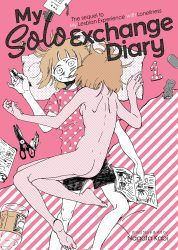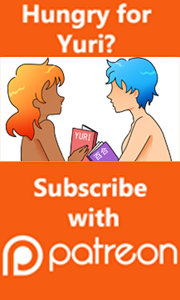Students of literature or art often find themselves reading analysis of an author’s work long past the author’s own lifetime, whether it be Edgar Allen Poe or Murasaki Shikibu. Manga and anime studies are not that old and, as a result, when one begins to study manga and anime in earnest, one sometimes encounters an unusual phenomenon – the subject of one’s research is often alive and still creating. Sure you might read about Tezuka Osamu, but you might also find yourself reading works by or about Riyoko Ikeda.
 A few years ago, I reviewed a manga that had been getting a lot of buzz in Japan. Based on an online diary, Sabishi-sugi Rezu Fuzoku ni Ikimashita Report (さびしすぎてレズ風俗に行きましたレポ) was breaking barriers and breaking sales records. The story itself – a manga autobiography of living with crushing depression and an eating disorder – was, I thought, unlikely to get an English translation. While diary comics had been published in translation previously, they were usually the work of well-established “elder” artists, such as Yoshihiro Tatsumi‘s A Drifting Life. Looking back at our own life in retrospect is, to some extent, the function of autobiography. So, even though we, as readers, have become more accustomed to the idea of the “real-time” diaries of social media as a way to understand our worlds in the form of blogs and social media posts, we don’t automatically assign that kind of communication a “literary” status until they become retrospective. Kabi Nagata changed that, in actual real time, while we watched.
A few years ago, I reviewed a manga that had been getting a lot of buzz in Japan. Based on an online diary, Sabishi-sugi Rezu Fuzoku ni Ikimashita Report (さびしすぎてレズ風俗に行きましたレポ) was breaking barriers and breaking sales records. The story itself – a manga autobiography of living with crushing depression and an eating disorder – was, I thought, unlikely to get an English translation. While diary comics had been published in translation previously, they were usually the work of well-established “elder” artists, such as Yoshihiro Tatsumi‘s A Drifting Life. Looking back at our own life in retrospect is, to some extent, the function of autobiography. So, even though we, as readers, have become more accustomed to the idea of the “real-time” diaries of social media as a way to understand our worlds in the form of blogs and social media posts, we don’t automatically assign that kind of communication a “literary” status until they become retrospective. Kabi Nagata changed that, in actual real time, while we watched.
By using social tools like Pixiv, and Twitter, Nagata gathered a global following with her diary – which was published in English in 2017 as best-selling manga My Lesbian Experience With Loneliness, proving me happily wrong.
It’s not often that we are able to see as an entire industry makes a shift into new territory right in front of us. It’s much more common that we only notice that change as we look back and learn about an artist’s contributions to their oeuvre after they are gone, like Julius Eastman‘s foundational work in downtown music. And so, I want to take a moment today to acknowledge what Kabi Nagata has done for manga, before she’s even had a chance to finish doing it.
Comic Essay
In the 2000s when I first started picking up Feel Young and other Josei magazines, among the manga included was a daily diary by well-known manga artist Erica Sakurazawa. She drew about her family and the kinds of typical situations in which an adult woman might find herself. This was my first encounter with what would soon become known as the “Comic Essay” genre. Common in magazines for woman, these comic essays by women gave the readers the sense that they were seen – that their lives were understood. Sakurazawa has continued to put out diary-style manga, as well as fiction and currently publishes comics on her blog as well as in print.
As the 2000s progressed, the “Comic Essay” section of Japanese bookstores grew in size. More artists contributed tales of child-bearing and child-raising. By the 2010s some of the top names in Jousei manga were drawing daily life comic essays. Comic essays are not only for or about women, consider Junji Ito’s Cat Diary, but I’m going to go out on a limb here and say that autobiographical comics resonate very strongly for women. Where men’s autobiographies tend to be bildungsroman about their adolescent development into adulthood, women’s autobiographies often center their ordinary lives, giving visibility to what remains invisible. Moyoco Anno’s manga about her life with her husband, celebrated anime director Hideaki Anno, Insufficient Direction, is a comedic essay about the ordinariness of two extraordinary people’s lives together. Comic essays remain a popular format for the display of women’s inner lives. Princess Jellyfish creator Akiko Higashimura has found a whole new kind of success with her autobiographical essay series Blank Canvas: My So-Called Artist’s Journey.
In the west, the artist who has seen the greatest commercial success with comic essays of her own life, is Raina Telegemeier, whose Smile, Sisters, and Guts gave voice to tween and teen girls worldwide. (Middle-grade readers are traditionally ignored by superhero comics companies but, are in actual fact, one of the top market for comics.) The editorial copy for Guts is telling, “Raina Telegemeier once again brings us a thoughtful, charming, and funny true story about growing up and gathering the courage to face — and conquer — her fears.” This is exactly the function of comic essays – uncovering those inner demons;low self-esteem, illness, even boredom and complacency in a relationship, and normalizing them. This is my life, comic essays say, this is your life.
By the 2010s, artists all over the globe were using social communities to draw their comic and manga essays. So when Nagata began her comic diary on art platform Pixiv, she was joining a tradition of great artists before her and bringing the format to a whole new generation of people. With My Lesbian Experience With Loneliness, Nagata, like Telegemeier, stood at the intersection of life and health and threw the door open.

 Graphic Medicine Manga
Graphic Medicine Manga
Among things that are universally “not to be discussed at the dinner table” universe, mental health and illness are right up there among the top, along with sex and politics. Humans are still unsure of how to deal with mental health, both medically and socially. For anyone in any media to admit to depression is still considered a form of “coming out” – an act of making public what is treated as a private burden.
In her first book, Nagata-sensei took her depression, the physical manifestations of that depression, and how it created an inability to form intimate relationships, into the public eye for people to see and comment on. Even behind a mask of pseudonymity, this was an act of bravery. And it was an act that changed people’s lives, as readers online thanked her and started sharing their own stories in her comments. What had been a purely private issue, something to not-be-discussed, was being uncovered and talked about.
While in the west comics creators were birthing a new graphic medicine genre with works like Jennifer Hayden’s The Story of My Tits, Nagata-sensei had opened the door to real stories of real people dealing with mental health issues in manga form.
Following the success of her first book, she continued her comic diary online. While working through her physical ailments, she started to have energy to address her relationship with her family and her desire and inability to build connections with other people. These became her series Hitori Koukan Nikki (一人交換日記), which were published in English as My Solo Exchange Diary, Volume 1 and Volume 2.
In the meantime, other manga artists had taken the opportunity to “come out” about mental health, as well. Akiko Morishima drew a lovely comic essay about living with ADHD in Otona no Hattatsu Shougai Kamoshirenai!? (おとなの発達障害かもしれない! ?). Morishima is known as a long-time Yuri artist with a very cute style of art. Her gentle art style doesn’t make the story any less powerful as she searches for ways to move forward with her new understanding, in a similar-yet-different path to Nagata’s own quest.
Yet another door has been opened, and I don’t think we’re likely to see it shut again. As mental health becomes increasingly de-stigmatized by those artists speaking up in public and normalizing mental health issues as just another kind of medical issue, it is likely to become more common, not less, to see more graphic medicine manga.

Queer Narrative
In western comics, the coming out narrative is so common, so expected, that even now I find myself surprised when I read a book or comic that doesn’t have at least a scene dedicated to the big reveal…even if, ultimately, that isn’t a thing for the other characters in a book. If there’s a defining quality to “coming out” in novels here in the USA in 2020, it’s that…it’s not a thing at all. Bye-bye coming out as trauma, we won’t miss you!
But manga is not science fiction, or YA, manga is another medium from a country that is slowly and steadily working towards LGBTQ equality, but is not there, not yet. Nonetheless, even in an industry as frequently heteronormative and conservative as manga publishing, queer-facing comics (as opposed to straight-facing comics about being sexual and gender minorities, like Gengoroh Tagame’s mainstream men’s manga My Brother’s Husband or Chii’s transgender life comic essay, The Bride Was a Boy,) are creeping in; artistic wildflowers growing up in the midst of a paved walkway. Takemiya Jin is one of the handful of out lesbian manga artists in Japan; her series Itoshi Koishi is an unusual Yuri manga that shows a young lesbian’s life as a wholly positive experience. Her older lover is kind and supportive and never pressures her in any way to do anything; her friends adore her and yet, when she feels that she wants to come out to them, she still feels stress. Coming out, which until recently was a hand-of-god narrative complication, resulting in loss of family, friends, and jobs, is less likely to be so dramatic these days, but it’s never easy.
One of the – even fewer – comic essays written by and about a woman in a relationship with another woman is in the same magazine that carried Itoshi Koishi, Comic Yuri Hime, a monthly Yuri manga magazine. Notice I don’t say it is a “lesbian comic”, or even a comic essay about lesbian life. For a monthly magazine that prints Yuri manga, there have been few lesbians in the 15 years of the magazine’s run.
So, when Nagata writes about herself in her first book, “By the way– when it comes to free hugs, gender doesn’t matter to me. But for anything more that that, I’d only want to purse it with a woman.” she joined that handful of out lesbian manga artists. That her narrative is not about being gay, but about her relationship with her body, with how she relates to (or doesn’t relate to) the world, does not change that her entire story is a queer woman’s story. And with that, Nagata flung open a third door in which a creator can relate with honesty, their sexuality and their relationship to their body.
 Not “The End”
Not “The End”
Nagata’s story is not over. This article is not a retrospective of an influential artist’s life and work after their death. Nagata is creating new work, even as we speak. She has fiction manga coming out shortly in an anthology and her own collection. She’s doing cover illustration and, while all of that is happening, she’s still telling her readers the stories about her life, her health, her trials and tribulations.
Like other comic essayists, Nagata has already given voice and visibility to people whose stories have been obscured. Here at the intersection, she’s laid groundwork for people to discuss their mental health and for queer folks to speak of their lives matter-of-factly.
In her most recent book, Genjitsu Touhishitetara Boroboro ni Natta Hanashi (現実逃避してたらボロボロになった話), Nagata chronicles even more serious physical ailments, this time pancreatitis as a side effect of alcohol abuse. We ride along as she once again pulls herself out of a deep well made in conjunction with the imbalanced chemical cocktail of her brain and body. It’s a testament to her strength of will (and a functional national healthcare system) that she is still capable of healing.
More importantly, as we read about her desire to create new, non-essay work, it’s a testament to her creative drive, her artistic and narrative abilities, that from inside all of these mental and physical health crises, there is a talented and unique voice who wants to be seen and heard. Perhaps then, she has more doors to blast through, as she gives voice to creatives whose work, rendered obscure by illness, poverty, gender, sexuality, ethnicity, skin color, ability or other forms of marginalization, find something in her story to resonate to.
Nagata has already changed what we read and how we read it, so it seems very fitting to also let her be the person who changes how we recognize that kind of paradigm shift, as well. Her body of work is notable enough that it’s worth noting now, during her life. I hope this will inspire other people to do more analysis of her work while she is still creating it and change the way literary critics will have to approach literary criticism for some time to come. ^_^
![]() In Volume 1, Konatsu moves to a small seaside town where she meets Koyuki, a sempai who is a member of the aquarium club. Konatsu wants to be friends with Koyuki, but she’s have a surprisingly difficult time communicating with the other girl.
In Volume 1, Konatsu moves to a small seaside town where she meets Koyuki, a sempai who is a member of the aquarium club. Konatsu wants to be friends with Koyuki, but she’s have a surprisingly difficult time communicating with the other girl.

